Monday, November 17 2014
Tesoro is the Spanish word for treasure, so it's no wonder this brand has been one of the industry's leading metal detector manufacturers for nearly 35 years. All 11 models are made in the USA and include a lifetime warranty. If you're looking for a brief comparison of the various models, below is a short description (in no particular order) of the strengths and price points of each Tesoro metal detector. Want to learn more about a particular model? Just click that link for greater detail and photos.
• Tesoro's Silver uMax is known for its capable, uncomplicated 2-knob operation. With both a sensitivity and a discrimination adjustment, the Silver uMax provides more information about your targets and the conditions of your hunt. This machine also offers the option to change search coils, enhancing the versatility of this ultra-lightweight machine. Not bad for just $254.15! • The Tesoro Outlaw Metal Detector ($437.75) represents the return of true no motion, all-metal treasure hunting. This machine has discrimination, sensitivity, threshold, and ground balance adjustments. The all-terrain Outlaw Coil Pack ($551.65) includes the detector and 3 coils: 5.75" concentric, 8" round concentric, and 12x10" widescan. The standard 8 inch coil provides great balance between depth and sensitivity and is an efficient pinpointer. The 5.75" coil utilizes tremendous sensitivity, making it an optimal tool for pinpointing targets. The 12x10 inch coil is less susceptible to ground effects, which means it is perfect for heavily mineralized sites or hunting larger targets. • Intelligence meets simplicity in Tesoro's DeLeon -- an easy to use, turn-on-and-go metal detector for $509.15. This smart machine features digital processing, which allows you to get the most out of the its coil's signal. The visual identification system works in two ways: the detector samples the signal and provides a 5-bar graph that indicates the signal's average, and a 2-digit ID number shows the max signal strength.
• And you'll never miss a target with the Tesoro Cibola either since it is a powerful turn-on-and-go metal detector. It provides pre-set mineral rejection, which leaves you more time to hunt and less time manually readjusting to different types of soil. The Cibola is perfect for detecting with friends because of its frequency shift, which allows you to choose between 3 different frequencies and eliminate interference between metal detectors. This ultra light-weight treasure finder offers the ability to super-tune, causing it to overdrive small signals for better clarity. This multi-faceted machine does everything a more expensive detector can do, at a fraction of the weight and cost (only $361.25). • Tesoro's Vaquero is an extremely effective machine, especially for an ultra- lightweight detector. It can do it all-- prospecting, coin shooting, and treasure hunting. The Vaquero has enough controls and features to be an excellent all-around machine that can be taken anywhere, yet the price is just $446.25. Manual ground balance allows users to control the Vaquero's response to the soil, even in highly mineralized locations. Similar to the Cibola, the Vaquero allows you to super-tune as well as shift frequencies when hunting with friends. • The $594.15 Tejon metal detector features a dual discriminator that is activated by an effortless trigger switch, allowing for an instant target check. This detector also includes a tone adjustment option that is designed for treasure hunters who have lost the ability to hear certain audio frequncies. The Tejon pushes the coil's signal deeper while increasing sensitivity for smaller targets. This unit is full of features that amount to more informed choices, less time digging trash, and most importantly -- more time hunting.
No matter which Tesoro metal detector you choose, the words of founder Jack Gifford hold true: "As the Spaniards were yesterday's undisputed masters of treasure hunting, we at Tesoro will always endeavor to meet our goal of making Tesoro Metal Detectors today's undisputed masters of treasure hunting." FREE SHIPPING on any detector priced $350 or more! Friday, November 07 2014
Bounty Hunter detectors have always attracted new people to the hobby of treasure hunting. If you haven't had a lot of experience with detectors, perhaps giving it as a gift and aren't sure how much the recipient will use it, and don't have a large budget, choosing the Bounty Hunter brand makes sense and cents. Beginners get a great detector that is easy to use, yet you don't break the bank buying fancy features that you don't understand, don't need, and take longer to master. The Tracker IV is definitely the most popular selling Bounty Hunter detector because of its great discrimination and ease of use. This is a basic analog detector with an All Metal, full Discrimination and a Tone Discriminant mode that automatically rejects iron targets. The Tracker IV automatic Ground Track feature allows operation in virtually all soil conditions, regardless of mineral content— and it's priced at less than $120! If you're looking for more of a "pro" model with a few more features, yet still want a detector that is considered to be turn-on-and-go, check Bounty Hunter's newest Pro models: Lone Star Pro ($179.10), Quick Draw Pro ($269.10), and Land Ranger Pro ($404.10). None of these have a large learning curve.
The Quick Draw Pro has depth, speed and
All of these Bounty Hunter detectors are lightweight (ranging between 2.5 to 3 pounds) and are covered by the manufacturer's 5 year warranty. Bounty Hunter metal detectors are made in the USA by First Texas Products, a company that has over 30 years of experience and a list of features and patents that keep the competition playing catch-up. First Texas also manufacturers the higher-end Fisher and Teknetics brand of detectors. Whether you want to find old coins, jewelry, or relics, these multi-purpose machines will help you uncover what lies beneath the dirt! These machines break down for easy storage. They can even fit into a suitcase so when you travel you can use it at parks or in the dry sandy areas on a beach. For beginners, Bounty Hunter offers the best quality and features for the price. So get set to dig deep... not into your pocket, but into the ground with a genuine Bounty Hunter metal detector that can eke out virtually any buried metal object! Monday, November 03 2014
Detectorists often argue the merits of manual versus automatic ground balancing a VLF (very low frequency) metal detector. Both have their pros and cons. Automatic is easier for beginners or anyone who wants a "turn on and go" experience. Automatic can be especially beneficial where the ground mineralization varies a lot because the detector tracks the ground mineralization for you as you move along, instead of requiring constant fiddling with controls on a manual unit. The downside of automatic ground tracking is that it can track out very faint gold signals in an attempt to eliminate ground signals. Small gold or larger gold that is buried deep, might be tracked out.
In theory, a perfectly ground balanced detector that has zero response to the ground is desirable. However, most experts would suggest setting the control to where there is a slight increase in sound as the coil is lowered to the ground. This is called setting the ground balance "hot" or "positive." Doing so will enhance the signal from very small or very deep nuggets. If the detector becomes slightly ground balanced to the negative side, it acts to suppress faint signals. Ground balancing a bit positive insures this condition is less likely to occur. Wednesday, October 29 2014
ANNOUNCEMENT: Fisher Research Labs is now offering upgrade options for the F75 and F75LTD metal detectors. With any upgrade, Fisher will trouble-shoot for common problems, give your detector a thorough tune-up and cleaning then return it in a new box with new manual. Typical turnaround time for an upgrade is 2-4 days not including shipping time. Existing warranty will cover any needed repairs and Fisher will contact you if out-of-warranty repairs are needed. With any upgrade you can also purchase an extended warranty. This is a great opportunity for you to renew or extend warranty coverage. If you currently have warranty coverage and want to purchase extended coverage, you will need to provide proof of purchase (original detector purchase receipt) from an authorized Fisher dealer. 3 year option is transferrable. Information on upgrade options provided below, but for full details and to order, visit the Fisher website here. Upgrade #1 –F75LTD to New Enhanced F75LTD OR F75 to New Enhanced F75 - $159.00
Upgrade #2 – F75 Original to New Enhanced F75LTD - $309.00
Upgrade #3 – FREE Upgrade. Any non-enhanced F75/F75LTD purchased between July 1 and December 31, 2014 with proof of purchase from an authorized dealer.
Optional Extended Warranty: Payment and Ordering: Sunday, October 19 2014
All metal detectors, regardless of brand or model, are susceptible to electrical interference. The high sensitivity of today's metal detectors combined with numerous sources of electromagnetic interference in our environment means you are likely to encounter electromagnetic interference at some point while out detecting. In general, the most sensitive models and brands tend to be affected more than lower-end models. Since you're likely to experience this, it's important to learn a little about electrical interference and its "symptoms" so that you don't unnecesarily send in your machine for repairs, and so you don't give up and leave a good hunt site too soon. Examples of interference include overhead and/or underground electric power lines, thunderstorms, electrical fences, electric motors, and VLF-UHF wireless communication systems such as cell phones, Bluetooth, Wi-Fi, etc. These common sources can cause a machine to "chatter" spontaneously, lose sensitivity for no apparent reason, or to cause "wobble" in the audio. What you might experience will depend on what model of detector you are using, the operating mode it's in at the time, and the source of the interference. It's interesting to note that small searchcoils usually pick up less electrical interference than larger coils, and concentrics usually pick up less electrical interference than a DD. All detectors are equipped with a sensitivity control (sometimes called gain or threshold). The primary reason detectors provide sensitivity control is so that users can reduce sensitivity in order to eliminate response to electrical interference. You might be hesitant to reduce sensitivity out of fear of losing depth, but don't be. The sensitivity control really is your first line of defense against electrical interference, so use it. Many mid-range and high-end detectors also have a "frequency shifting" control. This can be used to reduce or eliminate certain kinds of interference such as power lines, but it won't be effective against other types such an thunderstorms. Consult the user manual for your particular model for more information. Many detectors have both a Discrimination Mode and an All Metal Mode (often called Autotune Mode) which has a slower, smoother response than Discrimination. Electrical interference is often more controllable in the All Metal Mode than in Discrimination Mode. In the latter, you'll often find that although the machine may seem chattery if the searchcoil is not in motion, once you start to sweep, the signal from the ground will suppress the electrical interference chatter except for a random pop or click noise. When doing "air testing" indoors, you may find that changing the orientation of the coil makes a big difference in electrical interference pickup.
If you're experiencing a "noisy detector" but electrical interference is NOT the problem, then the culprit could be a defective searchcoil or its cable or connector. In many cases, a defective coil is intermittent, which can be determined by giving it a solid whack with your hand. If whacking it fixes the problem briefly, then you know for sure electrical interference is not a factor. Dirt or water in the coil cover or scuff could also cause problems. If you use a cover to protect your coil from abrasion, remove it periodically and clean it. Dirt and water can move around while you're sweeping, causing false signals. And although rare, a noisy detector could be caused by an internal calibration which has drifted over time. It is very uncommon in today's detectors, but if you have a very old machine, it's worth getting it checked out. Keep in mind that on most metal detectors, especially high performance models, the sensitivity can be adjusted high enough to "work into the noise." This is not a defect, rather an intentional design feature. Experienced detectorists striving for maximum depth often adjust the machine to "work into the noise" and then they listen "through the noise" for the sound of real targets. In general, if you experience a noisy detector, first determine if electrical interference could be the cause and use the advice listed above to overcome it. If you verify that the problem is not from electrical interference or improper use of your machine, by all means send it back to the factory for repairs. Monday, September 01 2014
In the spring of 1859, flakes of gold were found in Clear Creek, a tributary of the South Platte River in north central Colorado. Some prospectors were happy finding rich gold dust, but John Gregory w Within two months of Gregory’s initial gold discovery, 900 fortune-seekers were living in log shanties and tents. By the following summer, the population had swollen to 10,000. In no time, businesses and mills were thriving and the area became the leading mining center in the Kansas Territory. At this time, Colorado wasn’t yet a state, but its prominent place in mining history was already secured. Between 1859 and 1918 (considered by the National Register of Historical Places to be the area’s “period of significance”), the total gold output was $83,364,157! Most of this was in the form of placer gold, which was extracted with pans and sluices. This “easy” gold played out within the first five years of discovery, and by the end of 1863, most work had shifted to hard rock mining. The promise of riches continues to lure people to Central City today, but it’s not so much to find gold— but to gamble. Limited stakes gaming was legalized in 1991, and has made this area an important destination once again. Gambling was big business here in the 1880s, drawing the likes of Doc Holliday, and even Soapy Smith all the way from Alaska. The downtown core is now a National Historic District, and casinos reside in many of the restored historic buildings. Much of the beautiful and original woodwork, ceilings, and ornate furnishings date back to the 1870s. A scenic loop drive in the hills above the town is the place to find gold rush cemeteries, abandoned mines, headframes, and many other mining relics. Take a Walk The best way to learn more about Central City’s gold rush and admire its architecture at the same time is to stop at the Visitor Center on Eureka Street for a walking tour map. Choose from several self-guided walking tours, depending on your interests. Many of the town’s most magnificent buildings are in downtown, whereas Victorian residences are located outside of the business district. No matter how much ground you want to cover on foot, keep in mind you’re above 8,000 feet in elevation here, so pace yourself. Some buildings are open for guided tours (admission charged) but even if you don’t peek inside, you’ll get a good sense of the town’s history right from the street. If you want to shake hands with one-armed bandits or play poker at any time during your walk, you’ll find a chance to meet Lady Luck every step of the way.
In April of 1873, President Ulysses S. Grant came to see his friend Henry Teller. To impress the president, mine owners decided to lay 26 ingots of solid silver to make a path to the entrance to the Teller House so President Grant wouldn’t have to dirty his boots when he stepped from his carriage. Those wealthy citizens also had an ulterior political motive. At the time, Congress was debating whether gold or silver should back the dollar. Legend has it that Grant became angry when he saw the silver bars and walked up the boardwalk instead of on the silver path so as not to show favoritism. As we know, gold eventually won. The grand opening of the Opera House in 1878 (next door to the Teller House Hotel) started a tradition of community theatre, ranging from opera to vaudeville. Buffalo Bill Cody performed here as well as P. T. Barnum’s circus. The Opera House is known for its elaborately frescoed ceiling and perfect acoustics. In addition to Central City’s very popular Opera Festival held each summer, performances are held year round in this beautifully restored 550-seat theatre. The Opera Association also owns the Williams Stables building on Eureka Street. Initially constructed in 1876 for the use of Teller House guests, the building was purchased a few years later by Sheriff Dick Williams and his son. It was from here that a Stanley Steamer automobile could be had for hire— quite an achievement back in the day! Many of the Main Street establishments are identified by “blocks” and named for their original builders. In addition to the Teller House Hotel, Henry Teller also built the Teller Block for $6,000 in 1874. The upper floor was purchased a few years later by the Independent Order of Odd Fellows, which retained ownership until the 1990s. The Mullen Block was completed in 1874 by Thomas Mullen. Originally a drug store and clothing store, the Elks Lodge bought the building in 1902. The Harris Block was built in 1875 by Robert Harris and was home to the New York Store Mercantile that sold dry goods, clothing, and furnishings. Gold in Them Thar Hills The scenic forested hills above town offer evidence of the thousands of mining claims that placed Central City and the surrounding area in the history books. When you’re ready to take a short loop drive, the helpful staff at the Visitor Center will point you in the right direction. The route is mostly a well-maintained dirt road that takes you past headframes, abandoned mines, and sites of once thriving communities. Nevadaville is one such mining camp that 1,200 gold seekers used to call home. Along the route you’ll see the Coeur d’Alene Mine. Originally opened by Robert Cameron in 1894, the shaft reaches some 700 feet into the depths of Gunnell Hill. Records indicated that in 1915 this mine employed nine men who earned from $3-$4 per day. You’ll also see the shaft house of the Boodle Mill. Because of the serious safety hazard posed by abandoned mines, trespassing laws are strictly enforced. Although tempting to explore, keep away from old mines and tailings to avoid accidents.
The loop drive also takes you through the “cemetery district.” Many stories are told through the memorials and headstones. Harsh weather, less-than-clean water, mining accidents, and few physicians were the norm during the gold rush. So were epidemics of scarlet fever, diphtheria, and the Spanish flu. Sadly, you’ll notice that a large number of children are interred within the cemetery fences. When you visit, please remember these sites are historical grounds, but are also still in use today. The Gilpin County Historical Society also holds an annual “Cemetery Crawl.” "Oh My Gawd Road" After getting your fill of gold rush history and gambling, a popular route leading out of Central City to Idaho Springs takes about 30 minutes. It isn’t quite as bad as its moniker, but it’s not for the faint of heart either. The “Oh My Gawd” Road (CR 279) is more dirt than pavement and wouldn’t be wise for drivers who don’t like narrow, twisty roads, but the mountain views make it worth it. Along the bumpy route you’ll pass the famous “Glory Hole” mine workings, drive through Russell Gulch, and see many more mining relics that attest to “The Richest Square Mile on Earth” in days gone by. IF YOU GO: Central City is located in the Rocky Mountains, only 35 miles west of Denver. With the newly opened, Central City Parkway, visitors can reach Central City 12 minutes after exiting off of I-70 at exit 243. The Central City Visitors Center is located at 103 Eureka Street, at the northern end of Main Street in the old Wells Fargo Building. Articles and photos by Denise Seith. This article first appeared in the May 2014 issue of Gold Prospectors Magazine, published by the Gold Prospectors Association of America (GPAA). Wednesday, July 23 2014
Wouldn't it be nice if we all had access to geologists, drilling crews, and huge rock crushers to sample hardrock deposits? Well, if that's not in your budget but you still need to determine if an outcropping or vein might be promising before you stake a claim, a portable Cobra Crusher and a few grab samples can work nicely. A grab sample is just that -- randomly chosen rock samples you need to crush and test for gold or other precious metals. Although grab samples can seem counter productive because of the randomness, they can still provide you with a basic, overall understanding of the area and the possibility of higher grade ores in the vicinity. When looking for a grab sample, choose mineralized portions of the vein, pieces of mine dumps near a portal or shaft, or chunks of mineralized float that have broken away from the vein. Mineralized quartz on a mine dump near a mine portal or shaft makes for good grab samples. Often the operators of small mines had to sort and ship only the best of the ore. That means high grade materials can be left behind in mine dumps. What's especially great about the Cobra Crusher is that it's portable and light weight. You don't have to collect and then lug around heavy rocks and wait until you get back home or to your camp to know if they are worth anything. You can crush a few small rocks right in the field, then pan out the powder to see if its gold bearing. Having a small light-weight crusher with you in the field saves guess work. You'll know for sure right there and then if the site you've discovered is worth further consideration. If you don't have water to pan the powder on the spot, crush the rock and store the powder in a plastic bag. Label the bag with GPS coordinates so you know EXACTLY where you got it. Then, after you've panned it later, if you find it contains a good bit of gold, you will know exactly where to return for further testing. It's also helpful to snap a photo of the place where you collected the rock. Matching the GPS coordinates with your photo ensures you'll be able to get back to that exact spot at a later date. In addition to collecting rocks, you might want to take some chip samples from a wide vein. Use a rock hammer to break off small pieces and then run them through the Cobra Crusher. Again, pour the powder into a well labeled bag if you can't pan in the field and can wait until a later time to get the results. When preparing for a sampling expedition, use the information on your local Bureau of Land Management website or in their office. In these files, geologists might have made notes about the specific mines in the area, and/or there will be details about the ore grade, tonnage and past production -- all good indicators so you don't waste your time. Mine maps can often be found in these files as well. You might be able to locate old stopes or mapped veins. This information can tell you where high grade ores were found in the past, which is where you might want to explore today. Thursday, July 03 2014
Victor, Colorado -- the City of Mines Victor is a small quaint mountain town now, but back in the late 1890s, more than 8,000 lived and worked here. By the time the town was platted in 1893, it was already known as the City of Mines because the largest and richest gold mines of the Cripple Creek and Victor District were located on Battle Mountain just above town. Today, several headframes still jut into the sky, and brick buildings dating to 1899 still line the streets. Between 1899 and 1902, booming Victor boasted 48 saloons, 29 doctors, 15 restaurants, 12 banks, eight pharmacies, six churches, five architects, two newspapers and more. In early 1899, a fire destroyed the original false-front pine buildings and left 3,000 people homeless. Within six months, though, the businesses were rebuilt in brick or stone. Just like in Cripple Creek, Victor saw its share of the Colorado Labor Wars, too. The Western Federation of Miners union hall on 4th Street has some telltale bullet holes to prove it! Interpretive signs posted at intersections around Victor relate colorful stories about the Red Light Social Clubs, the famous girls who entertained at the Fortune Club, and about the town’s founders. Take a walk and envision the streets as they would have been over 100 years ago. If you need a little help imagining yesteryear, the photographs in the Lowell Thomas Museum depict life in early Victor, and it is also the best place to learn about the town’s pioneers. The museum’s namesake is none other than the internationally renowned radio news broadcaster, author, and film producer Lowell Thomas. Between 1930 and 1976, Mr. Thomas’s 15-minute nightly news and commentary aired just before the famous Amos ‘n Andy Show, and had a audience numbering more than that of the NBC, CBS and ABC TV news anchors combined. Victor was Lowell Thomas’s boyhood home. American Eagles Scenic Overlook
In 1895, the American Eagles Mine at this site was the highest underground mine in the district. This mine had three shafts, the deepest had reached 1,540 feet by 1902. Shafts are vertical excavations through which miners and supplies are taken into and out of underground workings. Headframes sit above the vertical shaft in order to support the sheave wheel or pulley system that passed the hoist cable from the steam or electric-powered hoisting mechanism to the metal cage that hauled men and supplies. Tunnels on the other hand, are horizontal excavations, driven from the surface into the side of a hill to connect with the underground workings some distance away. Technically speaking, tunnels have surface openings on both ends. A one-opening tunnel is an adit.
On your drive up to the American Eagles Scenic Overlook, expect to stop at a checkpoint and give your name to a Cripple Creek and Victor Gold Mining Company employee. Your visit is welcomed, so the checkpoint is for nothing other than your safety. You’ll be told if it is OK to proceed (the road is closed during blasting), and will be cautioned about the giant haul trucks that share part of the same road. Access the American Eagles Scenic Overlook north of Victor at the intersection of County Roads 81 and 83 on Bull Hill Pass. The route is signed. Trails of GoldThe remains of many mining operations pepper the landscape in and around Victor. Quite a few sites are connected by hiking trails (pick up a map at the visitor center in Victor). These “Trails of Gold” offer up-close looks at more relics of yesteryear as well as active mining activities. The trails include good signage about the area history. Some buildings are heaps of rubble, some are still standing— it all depends on Mother Nature. Be careful when exploring these sites, and if you’re normally a flatlander, remember that you’re trekking at elevations of 9,500-10,500 feet above sea level.
Cripple Creek and Victor continue to pay tribute to their 1890s heritage as The World’s Greatest Gold Camp. In and around these tiny towns, much of the area’s gold rush history has been preserved and continues to be a source of pride for the Centennial State (the nickname comes from Colorado becoming the 38th state, 100 years after the signing of the Declaration of Independence). Whether you want to tour gold mines, participate in year-round special events, visit museums, or just marvel at the historic headframes and other vestiges of mining equipment backdropped by mountain views, there’s a wealth of activities and sites to keep you interested and entertained. This photofeature by Denise Seith also appears in the May/June 2014 issue of Gold Prospector Magazine, published by the Gold Prospectors Association of America. Wednesday, July 02 2014
The Town of Cripple Creek, Colorado
In addition to its golden history, the restored town of Cripple Creek is now known for its casinos. Limited stakes gambling was approved by Colorado voters in 1990, so visitors can try to strike it rich 24 hours a day. If cards or craps or one-armed bandits don’t hold any appeal, skip the dozen or so casinos in town and instead enjoy the town’s many other attractions.
The Cripple Creek District Museum is housed in five original historic buildings— all filled with antiques and mining equipment. The Cripple Creek Heritage Center is a great place to learn about the entire Pikes Peak region. Looking for a highlight found in low lighting conditions? The Mollie Kathleen Gold Mine is located just outside of town, and is America’s only vertical shaft mine tour. After descending 100 stories, ride an air-powered mine train and learn how hard rock miners followed veins of gold. This historic mine was founded in 1891 and is named for its owner, Mollie Kathleen Gortner, the first woman in history to register a mining claim in her own name. Cripple Creek and Victor Gold Mining Company (CC&V) As you drive through the mining district today, you will see signs of active mining in just about every phase. The Cripple Creek and Victor Gold Mining Company (CC&V) operates a low-grade, surface gold mine, the largest in Colorado, between Cripple Creek and Victor. CC&V is doing extremely well and has poured in excess of 4 million ounces of gold from its Cresson Mine. CC&V, which has operated in the district for nearly 40 years, began its Cresson Project in 1995. The Cresson is named for the historic underground mining operation that was responsible for the famous great gold find of 1914— the “Cresson Vug.” A vug is a cavity in the rock, lined with crystals somewhat like a geode. The Cresson Vug produced 60,000 troy ounces of gold that was essentially picked from the walls of a room-sized void 1,200 feet below the surface. What a bonanza! If you’d like to see a working gold mining operation, CC&V hosts seasonal tours. Don’t miss this exciting opportunity to see giant haul trucks, shovels, and drill rigs in action. Watch boulders being crushed into gravel and learn about the safe, environmentally responsible mining and refining methods. Once you’ve seen a modern-day mining operation for yourself, you’ll gain another level of appreciation for the old-timers who didn’t have it so easy! And after learning about reclamation standards, you can set the record straight with those who argue that mining does nothing but permanently destroy the earth. Under current permits, CC&V plans to continue recovering gold here until at least 2026. If underground mining is resumed (exploratory results look good), work could be extended another dozen or so years beyond that. With an average pay and benefits package worth $80,000, several thousand CC&V employees are enjoying good paying jobs!
Tuesday, July 01 2014
Like most gold regions that boomed in the 1800s, Colorado’s Cripple Creek Mining District came from humble beginnings. Little more than cattle roamed the high valleys perched nearly two miles above sea level, and prior to ranching, generations of Ute Indians had lived off the land. But unlike most boomtowns, the gold never completely ran out here, and it continues to be mined successfully today. Historically, the Cripple Creek Mining District has produced over 24 million troy ounces of gold, along with some silver. That amount exceeds the combined production of the California and Alaska Gold Rushes! The millions made from 1891 through the present has earned it the distinction of “The World’s Greatest Gold Camp.” Today, the district is not only filled with gold rush era buildings and mining relics, but you can also tour real mines, visit interesting museums, ride the rails of a narrow gauge train, hike and bike while admiring mountain scenery, and even gamble on Lady Luck at the casinos. Pikes Peak Gold RushThe Pikes Peak Gold Rush officially began in 1859, a decade after the California Gold Rush. At that time, the land was still part of the Kansas Territory. The first color was actually found a few years earlier in 1850 at the confluence of Ralston and Clear Creeks, but John Ralston was California-bound, so the shiny stuff stayed where it lay… for a while. Several prospecting parties returned to Ralston Creek in 1858 and 1859, but didn’t find much. In fact, many were so discouraged that they didn’t stick around. The dedicated prospectors who persevered referred to those who gave up as the “Go Backers.” Soon enough, though, a few productive placer deposits were found along the South Platte River at the base of the mountains, the canyon of Clear Creek in the mountains west of Golden, and South Park. Word spread of these glittering discoveries, and “Pikes Peak or Bust” became a popular mantra. During the next several years, 100,000 gold-seekers headed for Colorado; 50,000 completed the journey; half of those became “Go Backers” and the remaining 25,000 turned a territory into a state in 1876. Cripple Creek Gold RushMost of the initial easy-to-reach gold deposits were largely played out by 1863, but then ranch hand Robert Womack started an even bigger gold rush. He found the shiny stuff in Cripple Creek in 1890, causing thousands of prospectors to head to the southwest slopes of Pikes Peak. Sadly, Womack died penniless several years later, even though his El Paso claim, which he sold for $500 and a bottle of liquor, produced millions of dollars in gold for the buyer. Between 1894 and 1917, over 500 mines operated in the Cripple Creek Mining District, which also included the thriving town of Victor. Headframes and other relics from many of those historic mines have been preserved, so it’s easy to get a good look up close. Perhaps one of the reasons it took 30 years for gold to be found in Cripple Creek following the state’s first gold rush is because no one expected gold, especially not millions of ounces, to be in this area. Most of the old-timers’ theories about how to locate gold just didn’t hold up here. Modern geologists know that areas that were highly volcanic in prehistoric times, are likely places to create rich underground deposits. The six square miles that comprise the Cripple Creek & Victor Mining District are located in the caldera of an extinct volcano. From what one frustrated miner wrote in Cripple Creek Illustrated, some early prospectors were stumped by the gold in this region: “Geographically, Cripple Creek is a freak. It is erratic, eccentric, and full of whims and caprices. That is, it is so to the man of science and the miner of experience. It is a vast crater bed in which the elements once were wont to make merry with nature and play unexpected pranks… The veins run here, there, and everywhere, cutting in all directions and even violating the theory that to have real value the vein should strike toward the poles of the earth.,, the experience has been that the deeper down into the earth the shafts penetrate, the richer is the ore, and the wider, more solid, and enduring the deposits.” |
|
Nugget of News Blog |






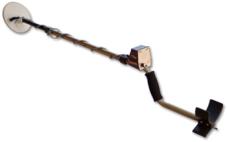

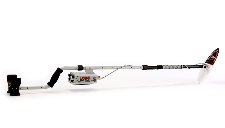 • Do you have gold fever? The Lobo Super TRAQ is an incredibly versatile, feature-rich machine that triumphs in small gold nugget prospecting. Spoil yourself with a detector that self-adjusts to any type of soil, even in highly mineralized locations. While the Lobo is designed to find gold, it also thrives in detecting coins, relics, and other treasures, too. A great value for only $679.15!
• Do you have gold fever? The Lobo Super TRAQ is an incredibly versatile, feature-rich machine that triumphs in small gold nugget prospecting. Spoil yourself with a detector that self-adjusts to any type of soil, even in highly mineralized locations. While the Lobo is designed to find gold, it also thrives in detecting coins, relics, and other treasures, too. A great value for only $679.15!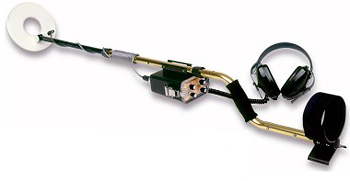

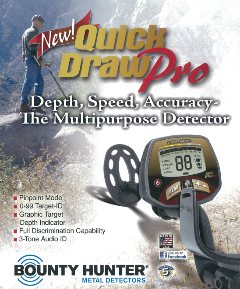
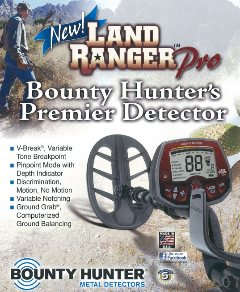
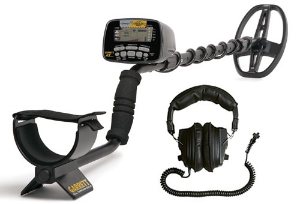 If you prefer a finer degree of control, manual ground balancing is achieved by raising and lowering the detector coil a few inches over the ground. The detector will sound off either as the coil approaches the ground or as it is raised away form the ground. The ground balance control is manipulated until there is no sound either raising or lowering the coil. The detector is now said to be ground balanced. (Always read your detector's Owners Manual, too, for instructions.)
If you prefer a finer degree of control, manual ground balancing is achieved by raising and lowering the detector coil a few inches over the ground. The detector will sound off either as the coil approaches the ground or as it is raised away form the ground. The ground balance control is manipulated until there is no sound either raising or lowering the coil. The detector is now said to be ground balanced. (Always read your detector's Owners Manual, too, for instructions.)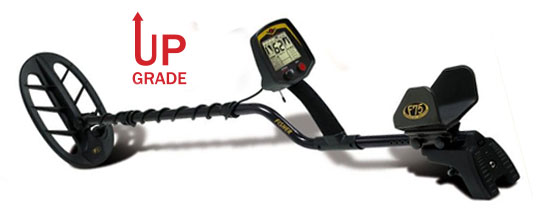
 If you carry a cell phone or other high-tech gadget with you out in the field, try turning it off (all the way off -- not just airport mode) and see if that solves the problem. When hunting near overhead power lines, you may get the best results right under the lines; the worst results occur about a 30 to 45 degree angle away. Many sources of interference are intermittent, so through trial and error you might find that a particular time of day or day of the week is makes it more or less difficult to detect. Power lines are usually quietest late at night and on early weekend mornings.
If you carry a cell phone or other high-tech gadget with you out in the field, try turning it off (all the way off -- not just airport mode) and see if that solves the problem. When hunting near overhead power lines, you may get the best results right under the lines; the worst results occur about a 30 to 45 degree angle away. Many sources of interference are intermittent, so through trial and error you might find that a particular time of day or day of the week is makes it more or less difficult to detect. Power lines are usually quietest late at night and on early weekend mornings. as determined to find the source. For months, the Georgia native followed North Clear Creek upstream from the present-day city of Golden, and on May 6, 1859, made the first lode discovery in the Rockies! Gregory sold his two claims for $21,000 a few months later and left the area, but his name carries on. “Gregory Gulch” is located between the towns of Central City and Black Hawk. The Gregory Mining District encompasses these towns plus several other mining camps, and as a whole, this area is referred to as "The Richest Square Mile On Earth.” Central City takes it name from being “central” to all the mining activity.
as determined to find the source. For months, the Georgia native followed North Clear Creek upstream from the present-day city of Golden, and on May 6, 1859, made the first lode discovery in the Rockies! Gregory sold his two claims for $21,000 a few months later and left the area, but his name carries on. “Gregory Gulch” is located between the towns of Central City and Black Hawk. The Gregory Mining District encompasses these towns plus several other mining camps, and as a whole, this area is referred to as "The Richest Square Mile On Earth.” Central City takes it name from being “central” to all the mining activity. One of the most notable buildings in downtown is the 150-room Teller House Hotel. Located on the corner of Eureka and Pine Streets, it was built in 1872 at a cost of $87,000, plus another $20,000 to furnish. From its non-descript exterior, you’d never believe that the Teller House was once considered to be the most elegant hotel between Chicago and San Francisco. Financed largely by Henry Teller, who became the first senator from Colorado and later, Secretary of the Interior, it’s no longer used as a hotel but is the center for opera-related activities (Central City Opera House is next door).
One of the most notable buildings in downtown is the 150-room Teller House Hotel. Located on the corner of Eureka and Pine Streets, it was built in 1872 at a cost of $87,000, plus another $20,000 to furnish. From its non-descript exterior, you’d never believe that the Teller House was once considered to be the most elegant hotel between Chicago and San Francisco. Financed largely by Henry Teller, who became the first senator from Colorado and later, Secretary of the Interior, it’s no longer used as a hotel but is the center for opera-related activities (Central City Opera House is next door).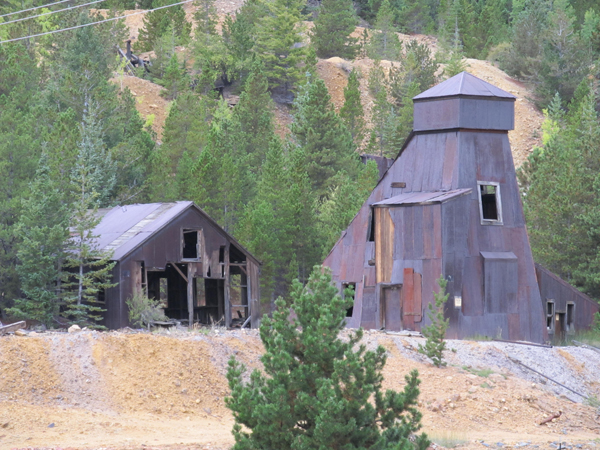 Known for their excellent stonework, the rock retaining walls visible in various places along the route were built by a very large population of Cornish miners. The walls were part of the former Gilpin Tramway, a 26-mile narrow gauge railroad that once looped around the gulches and through the surrounding communities. Sidings went to many of the major mines. Most of the retaining walls don’t use mortar, and were instead constructed using a dry-stack method. After more than a century, most of the rockwork is still holding up— no maintenance required.
Known for their excellent stonework, the rock retaining walls visible in various places along the route were built by a very large population of Cornish miners. The walls were part of the former Gilpin Tramway, a 26-mile narrow gauge railroad that once looped around the gulches and through the surrounding communities. Sidings went to many of the major mines. Most of the retaining walls don’t use mortar, and were instead constructed using a dry-stack method. After more than a century, most of the rockwork is still holding up— no maintenance required.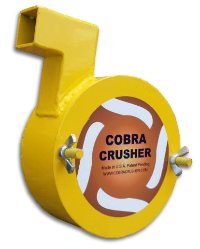
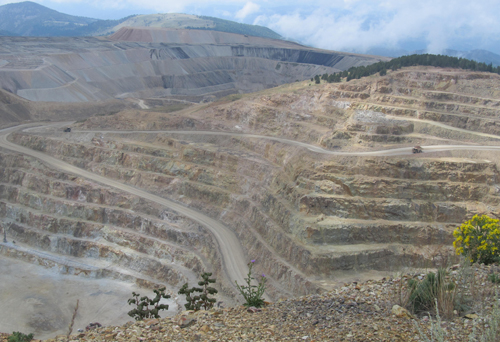 A few miles outside of Victor, you’ll find an impressive view of the Cripple Creek and Victor Mining District from atop the American Eagles Scenic Overlook. Stop at the Victor visitor center first (formerly a train depot) for a map. From an elevation of 10,570 feet, you get a bird’s eye look down into the CC&V surface operations where massive 240-ton haul trucks riding on 12-foot diameter tires haul ore up and down a abyrinth of roads. Mount Pisgah and the Sangre de Cristo and Collegiate Mountains make a nice backdrop.
A few miles outside of Victor, you’ll find an impressive view of the Cripple Creek and Victor Mining District from atop the American Eagles Scenic Overlook. Stop at the Victor visitor center first (formerly a train depot) for a map. From an elevation of 10,570 feet, you get a bird’s eye look down into the CC&V surface operations where massive 240-ton haul trucks riding on 12-foot diameter tires haul ore up and down a abyrinth of roads. Mount Pisgah and the Sangre de Cristo and Collegiate Mountains make a nice backdrop. 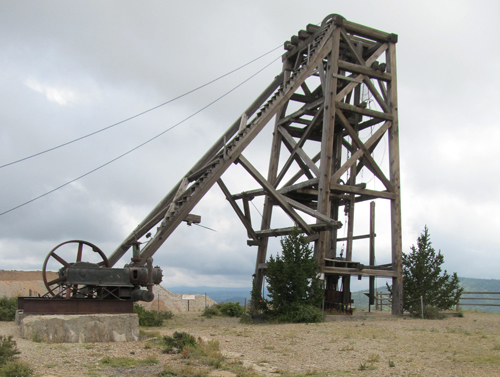 The original American Eagles headframe is still standing proudly, and the double-drum hoist is still in its place, too. The shaft, however, has been sealed. Remnants of a blacksmith shop and mine superintendent’s house are also at the overlook. Interpretive signs around the site tell the story of Winfield Stratton who purchased the American Eagles in 1895 after a huge success with his local Independence Mine. In fact, Mr. Stratton was Victor’s first millionaire and sold the Independence Mine for $11 million. The American Eagles was worked until 1940, but unfortunately little is known about its actual production since it was a private claim.
The original American Eagles headframe is still standing proudly, and the double-drum hoist is still in its place, too. The shaft, however, has been sealed. Remnants of a blacksmith shop and mine superintendent’s house are also at the overlook. Interpretive signs around the site tell the story of Winfield Stratton who purchased the American Eagles in 1895 after a huge success with his local Independence Mine. In fact, Mr. Stratton was Victor’s first millionaire and sold the Independence Mine for $11 million. The American Eagles was worked until 1940, but unfortunately little is known about its actual production since it was a private claim. The Independence Town Site is an interesting stop. The steel headframe of the Vindicator Mine is hard to miss, and a gravel path takes you past what’s left of a surface plant, ore processing facility, and a residence that has definitely seen better days. Independence originated as Hull’s Camp on the Hull City placer claim. Although some placer gold was found, the real riches came from underground veins, so there were several different mines here. The Vindicator is credited with producing a total of 1,244,000 troy ounces of gold between 1895 and 1953. Also nearby is what remains of the Theresa Mine, which produced over 120,000 troy ounces between 1895 and 1961.
The Independence Town Site is an interesting stop. The steel headframe of the Vindicator Mine is hard to miss, and a gravel path takes you past what’s left of a surface plant, ore processing facility, and a residence that has definitely seen better days. Independence originated as Hull’s Camp on the Hull City placer claim. Although some placer gold was found, the real riches came from underground veins, so there were several different mines here. The Vindicator is credited with producing a total of 1,244,000 troy ounces of gold between 1895 and 1953. Also nearby is what remains of the Theresa Mine, which produced over 120,000 troy ounces between 1895 and 1961.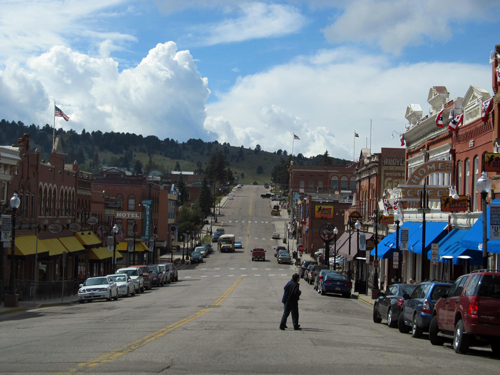 The gold rush not only brought prospectors into the quiet ranch town of Cripple Creek, but it brought in goods and services needed by those miners. Lumber yards, hotels, 100 saloons, 91 lawyers, 80 doctors, 40 assay offices, 14 newspapers, three railroads, two electric streetcar systems, and a trolley turned a small town into a booming gold camp of over 50,000. Interestingly enough, Cripple Creek was also the site of some of the worst mining labor conflicts in American history, culminating in the state militia being called in in 1903. Several celebrities also spent time here, including comedian and film star Groucho Marx, lawman and gambler Wyatt Earp, and boxer Jack Dempsey. Unfortunately, two accidental fires burned much of the city in 1896. Wisely, however, the city fathers declared that the business district be rebuilt in brick, and so many of those rebuilt buildings are still standing.
The gold rush not only brought prospectors into the quiet ranch town of Cripple Creek, but it brought in goods and services needed by those miners. Lumber yards, hotels, 100 saloons, 91 lawyers, 80 doctors, 40 assay offices, 14 newspapers, three railroads, two electric streetcar systems, and a trolley turned a small town into a booming gold camp of over 50,000. Interestingly enough, Cripple Creek was also the site of some of the worst mining labor conflicts in American history, culminating in the state militia being called in in 1903. Several celebrities also spent time here, including comedian and film star Groucho Marx, lawman and gambler Wyatt Earp, and boxer Jack Dempsey. Unfortunately, two accidental fires burned much of the city in 1896. Wisely, however, the city fathers declared that the business district be rebuilt in brick, and so many of those rebuilt buildings are still standing. 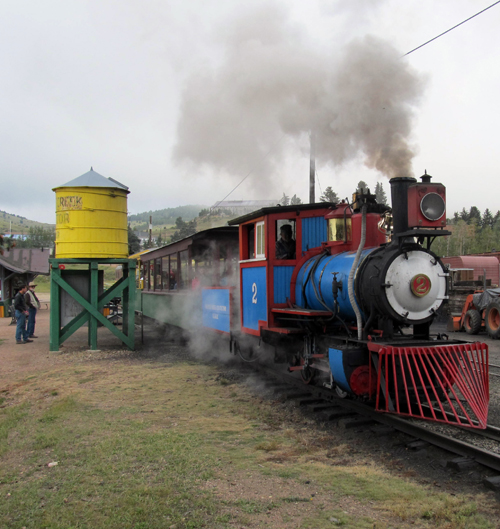 A four-mile narrated ride on the Cripple Creek & Victor Narrow Gauge Railroad passes several historical sites that can only be seen from the rails. The train is pulled by a coal-fired steam locomotive that looks a bit like Thomas the Tank Engine thanks to the baby blue paint. You can also see what it would have been like to be part of the criminal element in the early 1900s by visiting the Cripple Creek Jail Museum. It is housed in the red brick building that served as the Teller County jail from 1902 until the 1990s. The original cells are there, along with displays that highlight the laws and lawlessness of the 1890s.
A four-mile narrated ride on the Cripple Creek & Victor Narrow Gauge Railroad passes several historical sites that can only be seen from the rails. The train is pulled by a coal-fired steam locomotive that looks a bit like Thomas the Tank Engine thanks to the baby blue paint. You can also see what it would have been like to be part of the criminal element in the early 1900s by visiting the Cripple Creek Jail Museum. It is housed in the red brick building that served as the Teller County jail from 1902 until the 1990s. The original cells are there, along with displays that highlight the laws and lawlessness of the 1890s.  On Highway 67 between the towns of Cripple Creek and Victor, you will cross the highest bridge on the Colorado State Highway system. The bridge across Arequa Gulch was built in 2000-2001 for $418 million by the CC&V to accommodate their expansion. The 1,218 foot long bridge is over 250 feet tall at its highest point. The road is currently being rerouted again due to more growth. Near the bridge is CC&V’s leach facility and gold ore processing plant. The Valley Leach Facility (VLF) is where the gold is recovered from the ore by leaching with a sodium cyanide process solution. You can’t miss what looks like giant rock piles. The VLF actually functions like a big bathtub filled with crushed ore. The solution is applied to the ore using a drip irrigation system. The sodium cyanide process solution dissolves the gold and silver on the surface of the rock. The “bathtub” has a triple thick liner and a state-of-the-art monitoring and detection system to ensure zero discharge. The gold-bearing solution (called "pregnant solution”) is captured at the bottom of the liners. Gold is then recovered from the pregnant solution with a carbon absorption process. North of the VLF is the crushing facility that can process approximately 50 tons of ore per minute. Trucks load up the pulverized ore and delivery it to the VLF. This process recovers a whopping 200,000 ounces of gold annually. Eureka!
On Highway 67 between the towns of Cripple Creek and Victor, you will cross the highest bridge on the Colorado State Highway system. The bridge across Arequa Gulch was built in 2000-2001 for $418 million by the CC&V to accommodate their expansion. The 1,218 foot long bridge is over 250 feet tall at its highest point. The road is currently being rerouted again due to more growth. Near the bridge is CC&V’s leach facility and gold ore processing plant. The Valley Leach Facility (VLF) is where the gold is recovered from the ore by leaching with a sodium cyanide process solution. You can’t miss what looks like giant rock piles. The VLF actually functions like a big bathtub filled with crushed ore. The solution is applied to the ore using a drip irrigation system. The sodium cyanide process solution dissolves the gold and silver on the surface of the rock. The “bathtub” has a triple thick liner and a state-of-the-art monitoring and detection system to ensure zero discharge. The gold-bearing solution (called "pregnant solution”) is captured at the bottom of the liners. Gold is then recovered from the pregnant solution with a carbon absorption process. North of the VLF is the crushing facility that can process approximately 50 tons of ore per minute. Trucks load up the pulverized ore and delivery it to the VLF. This process recovers a whopping 200,000 ounces of gold annually. Eureka!